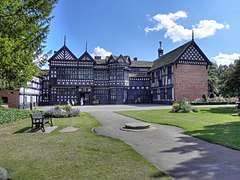Stockport Viaduct
| Stockport Viaduct | |
|---|---|
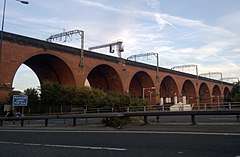 Stockport Viaduct | |
 Location within Greater Manchester | |
| General information | |
| Town or city | Stockport, Greater Manchester |
| Country | England |
| Coordinates | 53°24′33″N 2°09′51″W / 53.4091°N 2.1642°WCoordinates: 53°24′33″N 2°09′51″W / 53.4091°N 2.1642°W |
| Construction started | 1839 |
| Completed | 1840 |
| Cost | £70,000 |
| Client | Manchester and Birmingham Railway |
| Technical details | |
| Structural system | Brick arch |
| Design and construction | |
| Engineer | George W. Buck |
Stockport Viaduct is a large brick-built bridge carrying the West Coast Main Line across the valley of the River Mersey in Stockport, Greater Manchester, England (grid reference SJ89089030). It is one of the largest brick structures in the United Kingdom.
Stockport Viaduct was designed by the civil engineer George Watson Buck on behalf of the recently formed Manchester and Birmingham Railway company. In 1839, work commenced on the structure’s construction; consuming around 11,000,000 bricks, it was completed in 1840. The viaduct is 33.85 metres (111.1 ft) high.[1][note 1] At the time of its construction, it was the largest viaduct in the world, and it represents a major feat of Victorian engineering and a key pioneering structure of the railway age. Stockport Viaduct is a Grade II* listed structure,[2] and remains one of the world's biggest brick structures.[1]
In the late 1880s, Stockport Viaduct was expanded to accommodate four tracks across its deck instead of two. In the 1960s, overhead catenary lines were installed across the structure as a part of a wider electrification scheme conducted by the nationalised railway operator British Rail, allowing electric traction to traverse the structure. In the second half of the twentieth century, the M60 motorway, which circles the city, was built, passing through two of the viaduct's arches between Junction 1 (A5145 road) and Junction 27 (Portwood Roundabout).
History
Background and design
Following the launch and success of the first intercity railway, the Liverpool and Manchester Railway in 1830, there was considerable enthusiasm in the development of other routes between the major cities across Britain. The establishment of the Grand Junction Railway company, which sought to build a railway between the cities of Liverpool and Birmingham came early on; it soon held ambitions to establish a railway between the city of Manchester and the strategic railway junction of Crewe; in 1837, the venture was given royal assent by Parliament.
Stockport Viaduct, built to cross over the River Mersey and the surrounding valley, was designed by the civil engineer and accomplished bridge builder George Watson Buck of the recently formed Manchester and Birmingham Railway company; Buck also worked closely with the architect John Lowe to produce the viaduct’s design.[3] The envisioned path for the structure was already partially occupied by the engine house of the 1831 Wear Mill; its presence was addressed by designing the viaduct to cross directly over it, placing piers at either side of the engine house. In common with Stockport railway station, the viaduct was also historically referred to as Edgeley Viaduct.[3][4]
Structurally, Stockport Viaduct possesses a peak height of 33.8 meters above the bed of the River Mersey; it has a length of 546.2 metres and, originally, a width of 9.4 metres.[3] It comprises 22 semi-circular arches, each having a span of 19.2 metres and flanked by pair of abutment arches, possessing a 5.5 meter span, on either side. The arch rings have a thickness of 900mm.[3] Both the arches and spandrels are composed of red brick set in lime mortar, complete with ashlar spring courses. There are 2.2 meter-high parapets at each side of the viaduct; the distance between the crowns of the arches and the top of the parapets is 3.6 metres.[3]
The piers, which are composed of red brick, possess a thickness of 3 metres and a height of 12.2 metres.[3] Internally, they are solid up to 7.9 metres above the springings; above this point are 685mm thick walls, the interior space between being filled with ballast. For decorative purposes, the piers at the abutments feature rusticated facings.[3] The original track bed had a width of 8.7 metres and was ballasted with sandstone, sourced from neighbouring cuttings along the railway. Drainage of the track bed was achieved via a series of 100mm diameter iron pipes which allowed rainwater to be drawn away from the structure through the piers.[3]
Construction
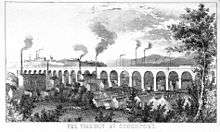
Several contractors were involved in the construction of Stockport Viaduct, including John Tomkinson and Samuel and John Holme.[3] Work was overseen by the project’s original resident engineer W. Adams, he was later substituted for by W.H. Perkins.[3]
At the peak of the work, around 600 workers were employed in shifts – working day and night – to complete the structure. The viaduct was entirely built of layer upon layer of common brick.[4] The structure took 21 months to construct; it was built at a total cost of £72,000; reportedly, around 11,000,000 bricks and 11,300 cubic metres of stone were used during its construction.[3][2] Both the scaffolding and centring used to build Stockport Viaduct’s arches were subsequently reused in the construction of the Dane Viaduct 15 miles to the south.[3]
While the Manchester to Stockport line was officially opened on 4 June 1840,[5] Stockport Viaduct was still incomplete until 21 December 1840.[3] On 16 July 1841, the first train traversed the structure; the viaduct was fully opened to rail traffic on 10 August 1842. The opening enabled the commencement of services through to Crewe, which in turn allowed passengers boarding at Stockport to travel readily to London.[3][6]
Operational life
The first section of the Manchester & Birmingham line to be completed ran from a temporary station in Manchester, at Travis Street, to a temporary station at Heaton Norris, on the Lancashire side of the Stockport viaduct. Originally opened for traffic on 4 June 1840, this short line proved to be an immediate success, carrying nearly 2,000 passengers per day during the second half of that year. Two years later, on 10 May 1842, train services were extended from Heaton Norris to Sandbach and the permanent Manchester station in Store Street was opened.
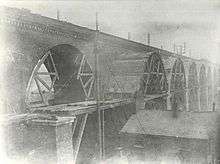
In the late 1880s, it was decided that Stockport Viaduct should be expanded to accommodate four tracks across its deck instead of two.[3] This decision has been largely attributed to the role of the London and North Western Railway, formed in 1846, which sought to have several tracks running along a single route so that slower trains could be readily overtaken. In order to add more tracks across the viaduct, it would need to be wider than its original configuration, which in turn necessitated such an expansion. Specifically, between 1887 and 1889, the viaduct was widened by approximately 6.8 metres along one side. The engineer responsible, Francis Stephenson, deliberately retained the dimensions and form of the original structure for the additional works.[3] Additional tapered piers were installed, while another abutment arch located at the Stockport end of the structure was also added to carry the expanded deck. This modification work was largely performed by direct labour.[3]
In 1929, the arch directly above Heaton Lane had to be repaired following several bricks falling from the soffit that year.[3] The degraded condition of the brickwork was attributed to the unseasonably high temperatures in the summers of 1915–1917 which had reportedly caused raising in both the track and parapet of the structure. In response, areas of damaged brickwork were replaced using reinforced concrete, the arch was re-grouted and new steel rails were installed across the affected area.[3]
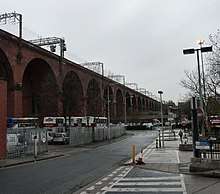
In the 1960s, overhead catenary lines were installed across Stockport Viaduct as a part of a wider electrification scheme which covered the majority of the West Coast Main Line.[7]
On 10 March 1975, Stockport Viaduct was recognised as a Grade II* listed structure.[3] In 1989, the viaduct underwent a programme of restoration works at an estimated cost of roughly £3 million. During this work, the exterior of the structure was intensively cleaned to improve its visual appearance.[3] The programme also included the addition of floodlights, which are used to illuminate the structure at night time.[6]
In the second half of the twentieth century, the M60 motorway, a circular bypass built around Manchester, was constructed over the course of several decades.[3] Its three-lane carriageways pass through two arches of the viaduct, between Junction 1 (A5145 road) and Junction 27 (Portwood Roundabout).[3]
In late 2007, Stockport Metropolitan Borough Council issued its formal objection to recently submitted service changes by train operator CrossCountry, which had proposed to reduce the number of Manchester to Birmingham trains stopping at Stockport by 50 per cent. Councillor David White claimed that an 1840 Act of Parliament guaranteed that all trains passing over the viaduct had to stop at Stockport station.[8] In response to this claim, local Labour MP Andrew Gwynne stated on his web page: "Sadly no such Act of Parliament exists, although it is common currency in the town that it does. I made enquiries with the House of Commons Library and the Parliamentary Archives back at the time some intercity trains stopped using Stockport. It appears it is purely an urban myth."[9]
In 2011, Stockport Viaduct was refurbished by national rail infrastructure owner Network Rail. However, by 2018, the visible condition of the structure had diminished, limestone staining (likely to be caused by failing waterproofing measures) and graffiti are present in multiple areas; local authorities are reportedly considering legal action to force Network Rail into addressing the declining condition of the viaduct.[10][11]
Stockport Viaduct has remained in regular use by main line services through to the present day, carrying passengers to destinations across the UK.[6] During its lifetime, it has made several contributions to literature and the creative arts, such as its mention in the introduction to the Northern Mill Towns in Elizabeth Gaskell's North and South. The viaduct has also appeared in several separate works by the noted landscape artist L.S. Lowry.[3]
Stockport rail accident 1948
Stockport Viaduct was the scene of a rail accident on 30 November 1948 at approximately 19:40 when in the darkness and in thick fog a combined Buxton service ran into the back of a combined Crewe and Disley service that was stopped at the signal at the south of the viaduct waiting for a platform. Although the collision was only at 10–15 mph, because of the inertial mass of the four locomotives, the last (11th) coach of the Crewe–Disley service telescoped into the tenth carriage. Five people lost their lives and there were 27 serious casualties. The impact point was approximately in the centre of the viaduct. The Inspector attributed the cause of the accident to the driver of the lead engine of the Buxton train, which was stopped at a signal just south of Heaton Norris railway station (now closed) misinterpreting a shout from the Assistant Porter as having been from the Guard as permission to proceed, which the Guard should have obtained from the signal box under Rule 55; as the signal not being visible in the dense fog: The train therefore passed the signal at danger.[12]
See also
- Grade II* listed buildings in Greater Manchester
- Listed buildings in Stockport
- Malbork Castle – largest brick structure in the world
Notes
- ↑ c.f. Göltzsch Viaduct in eastern Germany.
References
- 1 2 Historic England. "Stockport Railway Viaduct (76880)". PastScape. Retrieved 25 April 2008.
- 1 2 Historic England. "Stockport Viaduct (210778)". Images of England. Retrieved 29 February 2008.
- 1 2 3 4 5 6 7 8 9 10 11 12 13 14 15 16 17 18 19 20 21 22 23 24 “Stockport Viaduct.” ‘’engineering-timelines.com’’, Retrieved: 11 June 2018.
- 1 2 Edgeley Viaduct, Stockport, about 1890, Science and Society Picture Library,
- ↑ Francis Whishaw, The Railways of Great Britain and Ireland Practically Described, J. Weale, 1842, p. 306 google books
- 1 2 3 Stockport Metropolitan Borough Council. "Stockport Viaduct". Stockport.gov.uk. Archived from the original on 13 March 2008. Retrieved 24 October 2008.
- ↑ John Andrew Fairhurst. "Stockport Viaduct". Retrieved 20 April 2008.
- ↑ Morley, Victoria (14 November 2007). "Stop! Trains just 'passing through'". Stockport Express. M.E.N. Media.
- ↑ Gwynne, Andrew (29 August 2012). "Rail services to London via Stockport to be retained – MP". Retrieved 23 March 2014.
- ↑ Scapens, Alan. "Legal action could be taken against Network Rail over state of Stockport Viaduct." manchestereveningnews.co.uk, 6 February 2018.
- ↑ Scapens, Alan. "Stockport Viaduct is filthy and badly needs waterproofing. But it's not going to happen any time soon..." manchestereveningnews.co.uk, 24 April 2018.
- ↑ “Report on the Collision which occurred on 30 November 1948, at Stockport in the London Midland Region British Railways.” ‘’railwaysarchive.co.uk’’, Retrieved: 7 August 2013.
External links
| Wikimedia Commons has media related to Stockport Viaduct. |
.jpg)

